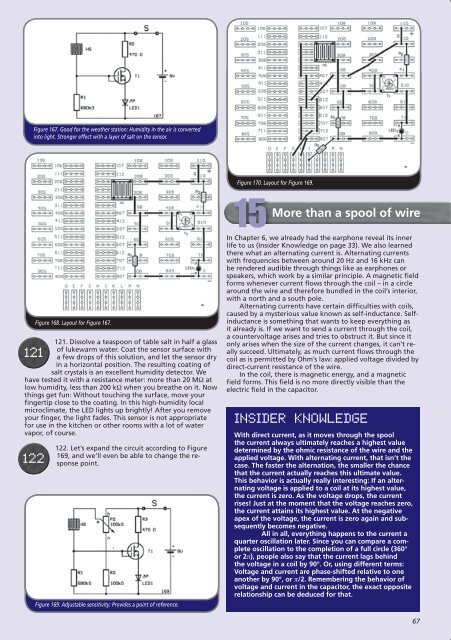615611 Electronics Workshop 2 Manual - Thames & Kosmos
615611 Electronics Workshop 2 Manual - Thames & Kosmos
615611 Electronics Workshop 2 Manual - Thames & Kosmos
Create successful ePaper yourself
Turn your PDF publications into a flip-book with our unique Google optimized e-Paper software.
Figure 167. Good for the weather station: Humidity in the air is converted<br />
into light. Stronger effect with a layer of salt on the sensor.<br />
122<br />
Figure 168. Layout for Figure 167.<br />
121 . Dissolve a teaspoon of table salt in half a glass<br />
of lukewarm water . Coat the sensor surface with<br />
121 a few drops of this solution, and let the sensor dry<br />
in a horizontal position . The resulting coating of<br />
salt crystals is an excellent humidity detector . We<br />
have tested it with a resistance meter: more than 20 MΩ at<br />
low humidity, less than 200 kΩ when you breathe on it . Now<br />
things get fun: Without touching the surface, move your<br />
fi ngertip close to the coating . In this high-humidity local<br />
microclimate, the LED lights up brightly! After you remove<br />
your fi nger, the light fades . This sensor is not appropriate<br />
for use in the kitchen or other rooms with a lot of water<br />
vapor, of course .<br />
122 . Let’s expand the circuit according to Figure<br />
169, and we’ll even be able to change the response<br />
point .<br />
Figure 169. Adjustable sensitivity: Provides a point of reference.<br />
Figure 170. Layout for Figure 169.<br />
15 More than a spool of wire<br />
In Chapter 6, we already had the earphone reveal its inner<br />
life to us (Insider Knowledge on page 33) . We also learned<br />
there what an alternating current is . Alternating currents<br />
with frequencies between around 20 Hz and 16 kHz can<br />
be rendered audible through things like as earphones or<br />
speakers, which work by a similar principle . A magnetic fi eld<br />
forms whenever current fl ows through the coil – in a circle<br />
around the wire and therefore bundled in the coil’s interior,<br />
with a north and a south pole .<br />
Alternating currents have certain diffi culties with coils,<br />
caused by a mysterious value known as self-inductance . Selfinductance<br />
is something that wants to keep everything as<br />
it already is . If we want to send a current through the coil,<br />
a countervoltage arises and tries to obstruct it . But since it<br />
only arises when the size of the current changes, it can’t really<br />
succeed . Ultimately, as much current fl ows through the<br />
coil as is permitted by Ohm’s law: applied voltage divided by<br />
direct-current resistance of the wire .<br />
In the coil, there is magnetic energy, and a magnetic<br />
fi eld forms . This fi eld is no more directly visible than the<br />
electric fi eld in the capacitor .<br />
INSIDER KNOWLEDGE<br />
With direct current, as it moves through the spool<br />
the current always ultimately reaches a highest value<br />
determined by the ohmic resistance of the wire and the<br />
applied voltage . With alternating current, that isn’t the<br />
case . The faster the alternation, the smaller the chance<br />
that the current actually reaches this ultimate value .<br />
This behavior is actually really interesting: If an alternating<br />
voltage is applied to a coil at its highest value,<br />
the current is zero . As the voltage drops, the current<br />
rises! Just at the moment that the voltage reaches zero,<br />
the current attains its highest value . At the negative<br />
apex of the voltage, the current is zero again and subsequently<br />
becomes negative .<br />
All in all, everything happens to the current a<br />
quarter oscillation later . Since you can compare a complete<br />
oscillation to the completion of a full circle (360°<br />
or 2π), people also say that the current lags behind<br />
the voltage in a coil by 90° . Or, using different terms:<br />
Voltage and current are phase-shifted relative to one<br />
another by 90°, or π/2 . Remembering the behavior of<br />
voltage and current in the capacitor, the exact opposite<br />
relationship can be deduced for that .<br />
67











